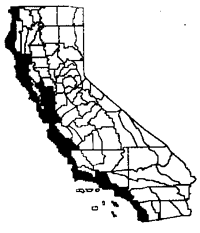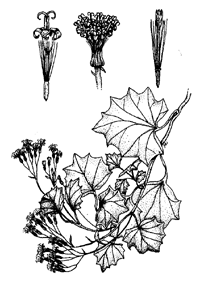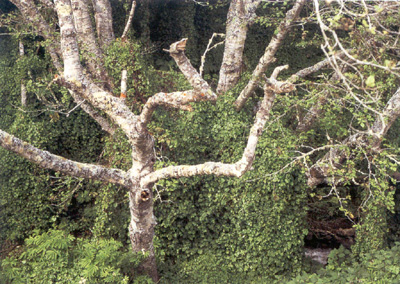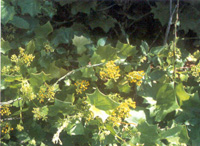Source: California Invasive Plant Council
URL of this page: http://www.cal-ipc.org/ip/management/ipcw/pages/detailreport.cfm@usernumber=41&surveynumber=182.php
Invasive Plants of California's Wildland
| Delairea odorata | ||||
| Scientific name | Delairea odorata | |||
| Additional name information: | Lemaire | |||
| Common name | German ivy | |||
| Synonymous scientific names | Senecio mikanioides | |||
| Closely related California natives | 36 | |||
| Closely related California non-natives: | 5 | |||
| Listed | CalEPPC List A-1,CDFA nl | |||
| By: | Carla Bossard | |||
| Distribution |
| |||
| HOW DO I RECOGNIZE IT? Distinctive features: |
Cape ivy (Delairea odorata) is a perennial vine with shiny, five- to six-pointed leaves, usually with two small stipule-like lobes. There is one leaf at each node. Foliage is green to yellow-green and has a distinct odor. Plants have extensive waxy stolons running above and below ground. Below-ground stems are purple. Each flower is a yellow, round discoid head the size of a dime. Flowers are arranged in groups of twenty or more. | |||
| Description: |
| |||
| WHERE WOULD I FIND IT? |
Cape ivy is invasive in Italy (Catalano et al. 1996), Australia (Fagg 1989), and the eastern United States, and currently occupies more than 500,000 acres in California (Grotkopf, pers. comm. 1998, Robison unpubl. data). It exists in many coastal forests the length of California, with populations found from Del Norte County in northern California to Canyons inland from San Diego. Typically found below 660 feet (<200 m) elevation, it prefers shady, disturbed sites with year-round moisture, such as stream banks, coastal forests in a fog belt, or soils with a high water table (Chipping 1993). In recent years populations have appeared in grasslands, open oak forests, coastal scrublands, Monterey pine forest, coastal bluff communities, seasonal wetlands, and even a few serpentine soils. In habitats without year-round moisture sources this vine dies back in the dry season, then grows rapidly during the wet season. It can survive in the Central Valley if it is near a water source (Bossard and Grotkopf unpubl. data, Cudney and Hodel 1986). | |||
| WHERE DID IT COME FROM AND HOW IS IT SPREAD? |
Cape ivy is native to moist mountain forests of South Africa, where it has a limited natural range. Introduced in the 1850s as an ornamental in the eastern United States and to California by the 1950s (Elliot 1994), by the 1960s it had naturalized in Golden Gate Park, San Francisco, and Marin County (Archbald 1995, Howell 1970). It spreads vegetatively by stolons and fragmentation of stolons. Ninety-five percent of fragments of green stolons containing only one node establish, and drying stolon fragments in full sun for ten weeks does not stop them from rooting (Bossard unpubl. data). | |||
| WHAT PROBLEMS DOES IT CAUSE? |
Cape ivy climbs over most other vegetation, forming a solid cover that blocks light and smothers other vegetation. The weight of the ivy mass sometimes causes trees to fall. Habitat for both plants and animals in protected natural reserves has been rendered worthless when large portions are occupied almost exclusively by cape ivy. Even in areas that have not become monospecific, native plant species richness can be reduced about 50 percent, with greater impact on annual than on woody perennial species (Alverez 1996). In the same study, native species seedling richness decreased 75 to 95 percent in areas containing cape ivy. Cape ivy contains pyrrolizidine alkaloids (Stelljes et al. 1991) and xanthones (Catalano et al. 1996) that make it unsuitable forage for most fauna. Pyrrolizidine alkaloids such as retronecine, found in cape ivy foliage and flowers, are known to be toxic to mammals and to spiders. Initial experiments indicate that cape ivy foliage contains compounds that decrease fish survival (Bossard 1998). Flood control function along streams is impacted by cape ivy infestations (Archbald 1995). Due to its shallow root system, cape ivy can contribute to serious soil erosion problems on hillsides (Cudney and Hodel 1986). | |||
| HOW DOES IT GROW AND REPRODUCE? |
Cape ivy apparently reproduces only vegetatively in California. In Australia and in its native South Africa it reproduces by seed as well, which results from homogamous, radiate, self-incompatible flowers. Cape ivy flowers extensively in California, but evidently forms non-viable seeds. There have been occasional reports of “seedlings” from several populations of cape ivy in California. However, when thousands of seeds from twenty-six populations throughout California were examined by O’Connell and Bossard in 1994, not one embryo-bearing, germinable seed was found (Bossard unpubl. data). It is possible the naturalized cape ivy in California is derived from a single genetic stock and, since this species is self-incompatible, California populations do not produce viable seed.
It flowers December to February. An experiment in Golden Gate Park (Alverez 1995) indicates that a single patch of cape ivy responds to resource changes more like an individual plant than a colony of individuals, allocating resources to developing regions or regions with decreasing resources from neighboring modules. | |||
| HOW CAN I GET RID OF IT? |
Cape ivy is difficult to eliminate for two reasons: stolons and underground parts readily fragment while being removed, and plants will grow from almost any remaining fragment. The most effective control technique depends on the site topography, proximity of water, type of non-target vegetation on the site, age and size of the infestation, importance of impacts to non-target species, and type and quantity of resources available for control efforts. All methods require appropriate timing, and possibly supplemental revegetation by desirable species. It is necessary to monitor removal sites every two months the first year and every four months the second year to locate and kill resprouts. Location and retreatment of resprouts is imperative or in six to eight months the ivy can reinfest the whole area from which it was removed. After the second year the site should be examined yearly to check for newly establishing populations. This is particularly important if a stream is present or if seasonal flooding occurs. Immediate removal of small new populations saves many hours of removal efforts a few months later and prevents further spread to other sites by fragmentation. � | |||
| Physical control: |
Manual removal has been attempted, sometimes successfully, in Volunteer Canyon, Marin County, Golden Gate National Recreation Area, San Francisco, and in parks in the Santa Cruz area. Manual removal requires clearing away native and invasive plant material to gain visual and physical access to locations with cape ivy stems emerging from the ground. Roots and stems must be teased out of the ground using a pointed or three-pronged mini-rake to loosen the soil. At some sites, where cape ivy is growing mat-like on the ground, it has been possible to roll up the entire infestation like a carpet using a potato hoe or rake (Archbald 1995). In Marin County volunteers were able to clear an average of 13.6 square meters of cape ivy per hour (Blumin and Peterson 1997). Removed cape ivy should be placed in or on plastic and, if feasible, removed from the area. Putting soda lime into cape ivy container bags will hasten the otherwise slow breakdown of this plant material. Manual control is sometimes followed with spot chemical treatment of resprouts. Cape ivy tissues should not be put through a chipper or sent unbagged to a dump site. Both would likely result in spread of cape ivy. Returning at four- to eight-week intervals is necessary to locate and remove overlooked and resprouting plants. Manual removal is labor-intensive but can be accomplished where chemical applications cannot be used. The amount of disturbance to non-target species varies with the type of vegetative community infested, but it can result in increased erosion or in colonization by other invasive plants. Supplemental revegetation needs should be considered on a site-by-site basis. Prescribed burning: This has not yet been attempted on cape ivy because of the high moisture content of its foliage. | |||
| Biological control: |
Insects and fungi: An initial assessment of potential biocontrol agents for cape ivy conducted in South Africa suggests that there are seven promising insect candidates, including moth and beetle larvae and root-, stem-, and seed-feeding insects (Grobbelaar et al. 1999). Led by CalEPPC, an effort is underway to raise funds to continue to support the efforts of the USDA Albany lab in developing biocontrol agents for cape ivy. Some of the more promising insects are being tested in South Africa. | |||
| Chemical control: |
A mixture of foliar-sprayed 0.5 percent glyphosate (as Roundup®) + 0.5 percent triclopyr (as Garlon 4®) + 0.1 percent silicone surfactant (as Silwit®) in water, applied as a foliar spray at 6.4 liters/ha proved effective in killing even long-established and extensive infestations of cape ivy in two applications, one year apart, in Golden Gate Park, San Francisco, and in a second test of this method near Morro Bay. Applications must be done in late spring when the plant is photosynthesizing actively but is past flowering, so the active ingredients move down with the sugars that are transported to underground storage organs. This mixture has a low concentration of active ingredients, which results in a slow, progressively deadly impact on dense cape ivy infestations with no measurable damage to non-target species (Bossard and Benefield 1995). Since the mixture contains a surfactant and triclopyr, it should be used cautiously and only within the guidelines specified on the label, especially where the water table is only a few inches below the surface or along pond or stream banks. In Australia, clopyralid, (sold in California as Transline®), was used successfully in concentrations of 150 g/liter clopyralid at application rates of 6-8 liters/ha to remove dense infestations of cape ivy using the rope wick method of application. This was done in two applications a year apart. Clopyralid substantially damaged non-target species in the Asteraceae, Solonaceae, Urticaceae, and Bignoneaceae families, but no appreciable damage was found on non-target species of other plant families (Fagg 1989). This herbicide is more expensive but also more selective than most other herbicides. Tests of glyphosate alone (as Rodeo®) and glyphosate + the surfactant R-11 at concentrations of 4 lbs/acre were carried out. While initial impact on above-ground foliage was high, extensive resprouting occurred from underground parts (Bossard and Benefield 1995). The rapid death of above-ground parts prevented translocation of the active ingredients to the roots and underground stems. | |||




